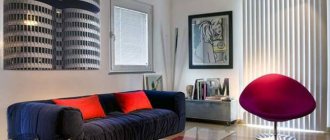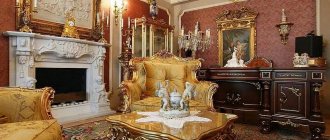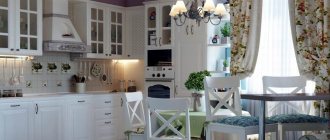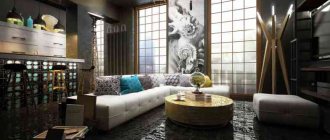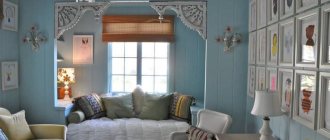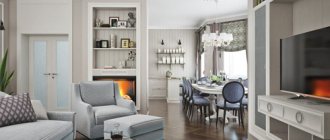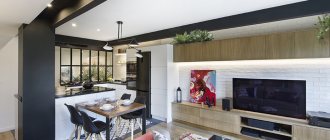What kind of houses do people live in in Norway?
Norway is known for its stunning nature (it is worth remembering its famous fjords), as well as its reverent attitude towards customs. Therefore, it is not surprising that, along with modern construction, houses continue to be built in the country using old, proven technologies.
Traditional fishing settlements gave rise to the architecture of modern private buildings. Housing is built from a carriage - a log hewn on opposite sides. The habit has historical roots: fishermen who were not wealthy were forced to save money and used fire monitor logs to build walls, and made floors and ceilings from slabs.
Eco-friendly and practical Source zinco.ru
It is clear where other characteristic features of Norwegian houses came from: the predominant one-story structure, windows with frequent frames (today these are bars in the form of a lattice) and the famous roofs covered with grass. Modern private housing is also built from gun carriages, but other technologies are also common: brick or panels. But grass roofs are becoming less and less common, mainly in exclusive projects.
In the 20th century, urban architecture changed the most. In Oslo and other cities in Norway you can find buildings erected under the influence of German neoclassicism, as well as a variant of Art Nouveau - Art Nouveau. Modern residential buildings and buildings are designed in the spirit of functionalism: they are characterized by clear, geometric shapes, large glass areas, bright facades with contrasting details.
Modern house in traditional style Source pinimg.com
Features of the Norwegian interior
Like houses, Norwegian interiors can also be divided into two large groups. One includes residential (usually urban) houses and apartments, decorated in the spirit of Scandinavian minimalism with a predominance of environmental trends and the addition of eclecticism characteristic of modern European style.
The second group of interiors is what is called Norwegian country; in spirit they resemble the chalet style. Norwegians value retro style, so the furnishings in their homes are often passed down from generation to generation. In such dwellings the influence of restrained national traditions is more strongly felt, life tends towards patriarchy; It is not uncommon to see carefully preserved antique furniture.
Retro style Source jillsorensenlifestyle.com
In general, we can highlight the following features of the Norwegian style in the interior:
- Aesthetics . Norwegians believe that aesthetics influences physical and emotional health, making it essential in harsh climates. Even building codes, which are designed to ensure full access to sunlight, are subject to this rule.
- Cosiness . Norwegian interior design aims to create bright, comfortable spaces that can help owners endure long winters with early twilight. It is important that beauty and comfort are considered an integral property of housing, available for implementation within any budget.
In a city apartment Source pufikhomes.com
- Functionality . In traditional houses, the living room is quite spacious, often combined with the kitchen; Bedrooms are small in size - a small room is easier to heat. In modern houses, the layout can be any; projects in which there is a second light in the living room are popular. Houses and apartments that have a sauna are valued.
- Identity . The desire to maintain a connection with nature and ancient interior details is not a fashionable trend, but a valuable part of the worldview.
On a farm in northern Norway Source citybreak.com
See also: Directory of companies that specialize in interior redevelopment
Distinctive features of the Norwegian interior
The most important distinguishing feature is the practicality and functionality of the interior. That is why original design and creativity will not find a warm welcome. It's too much. All elements are selected in such a way as to be useful and help cope with the gray reality outside the window. Namely, to create a cozy atmosphere and help keep you warm.
As a rule, houses in Norway are built from wood. Therefore, the inside is always wood trim. But even if the house is made of stone, using natural wood inside is the law, an unspoken rule for all Norwegians. And also a prerequisite for those who want to recreate this interior in their home. Parquet is laid on the floor, the walls are decorated with wooden slats, which often extend to the ceiling.
Materials in Norwegian interior
The Norwegian style uses materials typical of the Scandinavian Peninsula and its surroundings. First of all, it is worth mentioning natural wood, which is preferred to other materials in decoration, furniture and decor. Wooden surfaces are varnished (usually matte varnish) to reveal the texture, or painted white. The latter is more common in urban interiors in the southern part of the country.
Wood is the basis of style Source lillehammerfjellstue.no
Norwegian style combines wood with other materials; Brick, stone, concrete, glass, matte porcelain stoneware are welcome. Metal is used to a limited extent. These can be chandeliers with forged elements, lamps made of chrome or black metal.
In modern interiors there is space for plastic. This can be a material that imitates a natural surface (for example, a tabletop with the texture of wood or stone) or an object made of bright plastic in an eclectic solution. Additionally, natural textiles, leather, rattan, and ceramics are used.
Kitchen in a country house Source aviarydecor.com
Norwegian style bedroom
Since the Norwegian style is very good at helping to visually enlarge rooms, it is perfect for small bedrooms, which are so often found in modern apartments. You need to be especially careful with colored details characteristic of this style in the bedroom, because an excessive amount of bright colors will interfere with your ability to relax and sleep normally. In the bedroom, it is better to give preference to the lightest colors possible, and highlight only one wall and place the so-called accent on it. It is best when this wall is located behind the head of the bed. The ideal decorative pattern for the bedroom is a floral pattern. It is this that is most characteristic of Norwegian style.
Related article: Methods of fastening skirting boards and their features
All kinds of unusual objects will be the ideal decoration for a Norwegian bedroom. Don't be afraid and experiment. Place a wooden garden ladder in the room. It can be used, for example, instead of a clothes hanger or equipped on the stairs with a small shelf for pots of flowers. You can also replace the bedside table with an antique suitcase, poufs and chairs with a wooden bench, and instead of a door on the closet, hang a cute curtain.
Palette
Norwegian house designs were originally designed to make the most of natural light. It is not surprising that many people strongly associate Norwegian, like the entire Scandinavian style, with white color and bright space filled with IKEA furniture.
However, the Norwegian style, like all modern trends, is based not on strict rules, but on techniques, and therefore it is influenced by fashion trends in world design. Thus, in the 80s, pastel colors appeared in Norwegian interiors; a decade later they were replaced by earthy tones. Later, there was a fashion for light blue, lilac and violet shades.
In a classic palette Source pufikhomes.com
In recent years, the design has been filled with richer and more energetic colors: red, orange, coral, yellow. Often, pale blue, turquoise, or mint shades are chosen to decorate a living room or kitchen.
Despite the style’s loyalty to bright colors, the basis still remains white, gray and their derivatives, light and muted tones. The color of natural wood is complementary; the remaining shades are used in doses, mainly in decoration and textiles. The fashion for bright accents is more common in cities.
Black color is present only if it is functional: in the form of forged parts or the cast iron body of the fireplace stove.
Modern color scheme Source vox-cdn.com
The essence of Norwegian style
Note 1
The strict Norwegian style in architecture was formed under the influence of national traditions and climatic features.
The undoubted advantage of the northern Scandinavian regions is the beauty of nature with its mirror lakes, green forests and rocky mountains. Norwegian traditional buildings, built from natural materials, perfectly capture this spirit.
The main features of Norwegian architecture are:
- rationality of forms;
- harmony of colors;
- use of natural materials.
A typical Norwegian building is a low wooden house with regular geometry and restrained design. During design and construction, special attention is paid to the high quality of components and selection of materials. It is believed that the technology for constructing a Norwegian log house was borrowed by the Varangian mercenaries from ancient Russian architects. Much later, in the 18th century, Norway developed its own technology for constructing log frames, some aspects of which are still used today.
Finished works on a similar topic
Coursework Norwegian style 410 ₽ Essay Norwegian style 230 ₽ Test paper Norwegian style 200 ₽
Receive completed work or specialist advice on your educational project Find out the cost
Any Scandinavian style, including Norwegian, is associated with naturalness. In this regard, timber or logs are used as the main structural material. In recent years, frame construction technology has also gained popularity.
Walls and floor
Classic attractive minimalism - cool light shades of walls and warm wood floors - is a permanent classic of style. To reproduce it in wall decoration, they use different methods: they are plastered, trimmed with panels made of wood (or a high-quality imitation of it), wallpapered or painted.
The last method is especially common due to its simplicity and accessibility. Repainting allows you to quickly refresh the interior when you don’t have the time or finances for a full renovation. It is also a popular way of self-expression, although in most cases preference is still given to light colors.
Kitchen Source architectureforlondon.com
The naturalness of the Norwegian style in the interior is especially pronounced in the choice of material for the floor. The classic flooring is made of wide boards of light wood (pine, ash), but in reality parquet and laminate are also found everywhere, and the color of the floor increasingly varies over a wide range. Preferably wood with a natural texture; it is rarely painted white.
In the bathroom and in the kitchen work area (and sometimes in the living room), the wooden floor is replaced with tiles. Choose tiles of light shades; To make the surface more comfortable, install heated floors.
In the living room Source nordicbliss.com
Norwegian style in architecture
Wooden coverings in modern times are treated with various coatings that emphasize the pristine nature of the construction material. Untreated boards, darkened by time, are also readily used here. The main colors of the facade are beige, brown, black or sand.
It must be said that the facades of houses, as a rule, are minimalistic. However, the brightness of the colors and its contrast successfully compensate for such minimalism. Modern Norwegian houses today are built from concrete and brick. However, even here wood is often used in decoration; it harmoniously fits into the concept of natural tranquility.
Figure 1. Modern Norwegian architecture. Author24 - online exchange of student work
Are you an expert in this subject area? We invite you to become the author of the Directory Working Conditions
The lack of natural light played a special role in the formation of window openings in Norwegian buildings. Panoramic glazing is very popular in modern Scandinavian architecture. Large window openings allow you to constantly receive aesthetic pleasure and clearly emphasize the individuality of private houses. It must be said that panoramic glazing is gaining popularity only in modern times, with the development of technology. A large glazing area inevitably leads to large heat losses, so special attention should be paid to the calculation of heat-insulating materials and other enclosing structures.
The roof of a Norwegian house is most often gable. Sometimes a flat roof or rafter structure with small hip slopes is designed. This roofing meets the basics of simplicity and functionality. Tiles or metal profiles are usually used as a covering.
A mandatory element of a Norwegian private home is a porch or terrace. Often these two attributes are combined or, on the contrary, placed on opposite sides of the house. Typically, terraces and porches are made spacious in order to subsequently place a full-fledged recreation area in these areas. Terraces usually have simple shapes, they are designed open and have minimal decoration. The most popular finishing material here is also wood.
Summarizing the above, we can highlight a number of advantages of the Norwegian style in private architecture:
- practicality and conciseness of buildings;
- original and original exterior decor without frills;
- large functional window openings;
- reduced consumption of materials due to the simplicity of components and structures.
Window
They try to make them as large as possible so as not to lose a single ray of precious sunlight. Traditionally, it is not customary to hang curtains on windows, but it is not necessary to adhere to age-old rules. It won’t hurt your style if you decorate the window opening with light curtains, Roman shades or blinds.
Roman curtains - a suitable decor option Source squarespace-cdn.com
Furniture
The original Norwegian interiors developed gradually; the owners have filled their homes with furniture and accessories over the years. Furniture that forms the basis of the Norwegian style can be described in the following rules:
- Preference is given to items made of light wood (pine, birch, beech, ash). The coffee table top can be glass.
- Interestingly, bookshelves, work tables, and chests of drawers are often painted white. Tables with chairs, beds, sofas and cabinets are made from natural wood with preserved texture, but the opposite option is also possible.
Dining room Source pinimg.com
Lighting and accessories
A variety of lighting devices help compensate for the lack of sunlight. They try to make the lighting complex, multi-level. In addition to standard overhead lighting (for example, chandeliers with candles), a variety of sconces and floor lamps are used. A separate lamp is hung above the dining table, auxiliary lighting is mounted in the work area in the kitchen.
Combined lighting in a city apartment Source squarespace-cdn.com
The Norwegian style in the interior is characterized by a minimum of decor, with preference given to items made from natural materials. If something decorates the room, it is a wooden figurine, photographs in wooden frames, a flower in a ceramic pot.
There is little textile - despite the harsh winters, Norwegians do without carpets on the floor, preferring pillows made of natural cotton. If you want to add a rug, choose one in light, gray or beige shades. It can be replaced with a handmade rug with a geometric pattern.
Norwegian style accessories Source blogspot.com
Lighting and accessories in a Norwegian home
Scandinavians successfully compensate for the lack of natural light by using a large number of lighting fixtures. Chandeliers and floor lamps, lamps and candles, sconces and table lamps are used. In this case, a combination of shapes, sizes and styles is quite appropriate. Norwegians and residents of other Scandinavian countries boldly experiment with lighting, using it to zone space and place important accents in the interior.
Norwegian style in the interior presupposes the presence of a minimum of decorative elements. At the same time, their appearance is given great importance. They should be expressive, functional, and not too complicated. Naturalness and originality are encouraged in the decor, so the use of accessories made from natural materials is encouraged.
Mirror surfaces, which visually enlarge the space and fill it with light, will be very useful in Scandinavian interiors. An excellent addition would be figurines and dishes made of porcelain, ceramics and metal, and numerous candles. An abundance of textiles is welcome
in the form of bright blankets, capes, pillows and carpets with floral or geometric patterns. The Scandinavian interior is characterized by the placement of paintings, posters and family photographs on the walls.
If you value the warmth of a homely environment filled with an atmosphere of serenity, decorate your home in Norwegian style. Westwing's practical recommendations will help you radically update your interior without any special expenses.
Briefly about the main thing
Norwegian interior style is an integral part of Scandinavian design, but it also has its own differences. The direction was formed in the harsh climate of high latitudes, which affected both the appearance of the houses and their contents.
In interior design, a distinction is made between farm (rural) and urban styles. In the first, traditional features are more noticeable, the second gravitates towards eclecticism and contemporary. Must-have features for a Norwegian home include large windows, wooden floors and a light palette that can be mixed with current colors. Unlike the rest of Scandinavia, vintage furniture is practically not used to decorate the premises.
Ratings 0
Main characteristics of the style
The Norwegian style cannot be confused with anything else. It has a lot of distinctive features.
- The main rule of style is minimalism in everything. However, unlike the same minimalist style, in the Norwegian style everything is more reasonable. Do not remove necessary items out of sight in order to achieve free space. Just get rid of everything that's really unnecessary.
- Window decor should be minimal, and it is better to get rid of any curtains or curtains altogether. The main goal of this solution is to get the maximum amount of sunlight. If you can't live without some kind of curtains, limit yourself to sheer tulle, but don't choose bulky dark curtains.
- Most of the materials used in the interior are natural, and the most “important” material is wood. Wood can be present in decoration (on walls, on floors and even on ceilings) and in furniture elements. Particular preference is given to birch, oak and beech. But the wood finishing should be minimal, because everything in the Norwegian interior always looks natural and natural. Limit yourself to regular wood painting.
- The interior should be as functional as possible. Try to use every little thing. Everything should be simple and comfortable.
Related article: Phototulle and photocurtains: what to look for when purchasing


